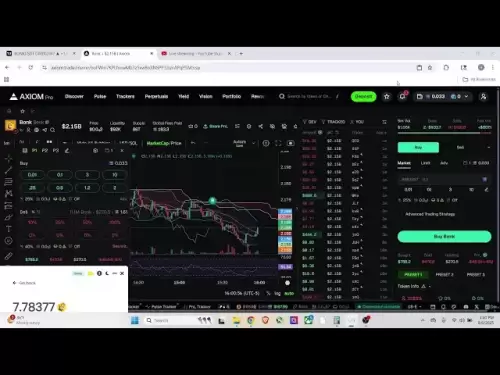-
 Bitcoin
Bitcoin $116300
2.01% -
 Ethereum
Ethereum $3815
5.35% -
 XRP
XRP $3.071
4.46% -
 Tether USDt
Tether USDt $1.000
0.02% -
 BNB
BNB $776.2
1.67% -
 Solana
Solana $173.0
5.70% -
 USDC
USDC $0.9999
0.00% -
 TRON
TRON $0.3389
1.14% -
 Dogecoin
Dogecoin $0.2125
5.92% -
 Cardano
Cardano $0.7627
5.16% -
 Hyperliquid
Hyperliquid $39.00
4.42% -
 Stellar
Stellar $0.4122
5.07% -
 Sui
Sui $3.654
7.22% -
 Chainlink
Chainlink $17.31
5.47% -
 Bitcoin Cash
Bitcoin Cash $582.2
4.28% -
 Hedera
Hedera $0.2521
3.53% -
 Ethena USDe
Ethena USDe $1.001
0.01% -
 Avalanche
Avalanche $22.77
3.47% -
 Litecoin
Litecoin $119.6
2.53% -
 UNUS SED LEO
UNUS SED LEO $8.944
-0.49% -
 Toncoin
Toncoin $3.288
3.95% -
 Shiba Inu
Shiba Inu $0.00001261
3.78% -
 Uniswap
Uniswap $10.12
5.80% -
 Polkadot
Polkadot $3.761
4.23% -
 Dai
Dai $1.000
-0.01% -
 Monero
Monero $285.1
-2.37% -
 Bitget Token
Bitget Token $4.387
1.43% -
 Cronos
Cronos $0.1476
5.88% -
 Pepe
Pepe $0.00001080
4.75% -
 Ethena
Ethena $0.6374
11.58%
How to find the support and resistance levels of XRP?
Analyzing XRP's historical data and using technical indicators like moving averages and volume helps identify reliable support and resistance levels for trading decisions.
Apr 20, 2025 at 11:42 am

Introduction to Support and Resistance Levels
Understanding support and resistance levels is crucial for any trader or investor looking to navigate the volatile world of cryptocurrencies like XRP. These levels help in identifying potential price points where the price of XRP is likely to reverse or continue its trend. Support levels are the price points where the demand for XRP is strong enough to prevent the price from falling further, while resistance levels are where the supply of XRP is sufficient to stop the price from rising further. By identifying these levels, traders can make more informed decisions about entry and exit points for their trades.
The Importance of Historical Price Data
To find the support and resistance levels of XRP, the first step is to analyze historical price data. This data provides insights into how XRP has reacted at different price points in the past. Accessing historical price data can be done through various cryptocurrency charting platforms such as TradingView, Coinigy, or even directly from exchanges like Binance or Coinbase. Once you have this data, you can start plotting the price movements of XRP over time to identify patterns and levels where the price has historically reversed or stalled.
Identifying Support Levels
Support levels can be identified by looking for areas where the price of XRP has bounced back after reaching a certain low. These are typically characterized by a concentration of buying interest that prevents the price from falling further. To find these levels, follow these steps:
- Open a charting platform and select XRP as the asset you want to analyze.
- Set the time frame to a longer period such as daily or weekly charts to get a broader view of historical price movements.
- Look for price points where XRP has reversed its downtrend multiple times. These points often form horizontal lines on the chart and are potential support levels.
- Confirm the support level by observing if the price touches this level and bounces back multiple times over different periods.
Identifying Resistance Levels
Resistance levels are the opposite of support levels and can be identified by looking for areas where the price of XRP has struggled to break through to higher levels. These are typically characterized by a concentration of selling interest that prevents the price from rising further. To find these levels, follow these steps:
- Open a charting platform and select XRP as the asset you want to analyze.
- Set the time frame to a longer period such as daily or weekly charts to get a broader view of historical price movements.
- Look for price points where XRP has reversed its uptrend multiple times. These points often form horizontal lines on the chart and are potential resistance levels.
- Confirm the resistance level by observing if the price touches this level and reverses back multiple times over different periods.
Using Technical Indicators to Refine Levels
While historical price data is a great starting point, using technical indicators can help refine the support and resistance levels of XRP. Some commonly used indicators for this purpose include:
- Moving Averages: Simple Moving Averages (SMA) and Exponential Moving Averages (EMA) can help identify dynamic support and resistance levels. For example, the 50-day and 200-day moving averages are often watched closely by traders.
- Fibonacci Retracement: This tool helps in identifying potential support and resistance levels based on the Fibonacci sequence. By drawing Fibonacci retracement levels on a chart, traders can pinpoint areas where the price might reverse.
- Bollinger Bands: These bands can help identify volatility and potential reversal points. When the price touches the lower Bollinger Band, it may indicate a support level, and when it touches the upper band, it may indicate a resistance level.
To use these indicators:
- Add the chosen indicator to your XRP chart on the charting platform.
- Observe how the price interacts with the indicator. For example, if the price consistently bounces off a moving average, it can be considered a support or resistance level.
- Combine multiple indicators to get a more comprehensive view of potential support and resistance levels.
The Role of Volume in Confirming Levels
Volume is another critical factor in confirming support and resistance levels. High trading volume at a particular price level can indicate strong interest from buyers or sellers, making it a more reliable support or resistance level. To incorporate volume in your analysis:
- Add a volume indicator to your XRP chart.
- Look for spikes in volume at the identified support and resistance levels. If the volume is high when the price touches these levels, it adds credibility to the level.
- Compare volume across different time frames to ensure that the level is significant across various periods.
Practical Example of Finding Support and Resistance Levels
Let's walk through a practical example of finding support and resistance levels for XRP using historical price data and technical indicators.
- Open a charting platform like TradingView and select XRP/USD.
- Set the time frame to a weekly chart to get a long-term view.
- Identify historical price points where XRP has reversed its trend. For example, if XRP has bounced back multiple times at $0.20, this could be a support level.
- Add a 50-day SMA to the chart. If the price consistently bounces off this moving average, it can be considered a dynamic support or resistance level.
- Draw Fibonacci retracement levels from a significant high to a significant low. Look for areas where the price has reversed at these levels, such as the 38.2% or 61.8% retracement levels.
- Add Bollinger Bands to the chart. If the price touches the lower band and bounces back, it could indicate a support level, and if it touches the upper band and reverses, it could indicate a resistance level.
- Observe the volume at these identified levels. High volume at $0.20 would confirm it as a strong support level.
Frequently Asked Questions
Q: How often should I update my support and resistance levels for XRP?
A: It's advisable to review and update your support and resistance levels regularly, especially after significant price movements or market events. Weekly or monthly reviews can help keep your analysis current.
Q: Can support and resistance levels change over time?
A: Yes, support and resistance levels can change as market conditions and trader sentiment evolve. What was once a strong support level may become a resistance level if the price breaks below it, and vice versa.
Q: Are support and resistance levels more reliable on longer time frames?
A: Generally, support and resistance levels identified on longer time frames, such as weekly or monthly charts, tend to be more reliable and significant than those on shorter time frames like hourly or daily charts.
Q: How can I use support and resistance levels to set stop-loss orders for XRP?
A: You can set stop-loss orders just below a support level to limit potential losses. For example, if $0.20 is identified as a support level, you might set a stop-loss order at $0.19 to protect your position if the price breaks below the support.
Disclaimer:info@kdj.com
The information provided is not trading advice. kdj.com does not assume any responsibility for any investments made based on the information provided in this article. Cryptocurrencies are highly volatile and it is highly recommended that you invest with caution after thorough research!
If you believe that the content used on this website infringes your copyright, please contact us immediately (info@kdj.com) and we will delete it promptly.
- BlockchainFX, Bitcoin Swift, Crypto Presales: What's the Hype?
- 2025-08-07 19:10:13
- SHIB Community at Crossroads: Shytoshi Kusama's Leadership Under Scrutiny as Elections Loom
- 2025-08-07 18:30:13
- IREN Overtakes: A New King in the Bitcoin Miner Hashrate Race?
- 2025-08-07 16:31:29
- Memecoins Mania: Whales Eye Pepe Dollar (PEPD) as Bonk Cools Off, While MoonBull Hogs the Spotlight!
- 2025-08-07 16:51:17
- Unilabs, PEPE, and Investment Risk: Navigating the Crypto Hype
- 2025-08-07 16:31:29
- Meme Coin Mania: Rug Pulls, CZ-Inspired Tokens, and the Wild West of Crypto
- 2025-08-07 16:57:14
Related knowledge

How to avoid common crypto investment mistakes?
Jul 13,2025 at 01:35am
Understanding the Risks of Crypto InvestmentInvesting in cryptocurrency can be highly rewarding, but it also comes with significant risks. One of the ...

What is a long-short crypto strategy?
Jul 15,2025 at 10:56am
Understanding the Basics of a Long-Short Crypto StrategyA long-short crypto strategy is an investment approach where traders simultaneously take long ...

What is a long-short crypto strategy?
Jul 11,2025 at 01:28pm
Understanding the Basics of Long-Short Crypto StrategyA long-short crypto strategy is an investment approach where traders take both long and short po...

How to use the RSI indicator for crypto?
Jul 12,2025 at 03:56pm
Understanding the RSI Indicator in Cryptocurrency TradingThe Relative Strength Index (RSI) is a momentum oscillator used to measure the speed and chan...

Is copy trading a good strategy for crypto beginners?
Jul 12,2025 at 08:28am
Understanding Copy Trading in the Cryptocurrency MarketCopy trading is a strategy where novice traders replicate the trades of experienced investors a...

How to build a crypto portfolio with $1000?
Jul 13,2025 at 08:14pm
Understanding the Basics of Cryptocurrency InvestmentBuilding a crypto portfolio with $1000 starts with understanding the fundamentals of cryptocurren...

How to avoid common crypto investment mistakes?
Jul 13,2025 at 01:35am
Understanding the Risks of Crypto InvestmentInvesting in cryptocurrency can be highly rewarding, but it also comes with significant risks. One of the ...

What is a long-short crypto strategy?
Jul 15,2025 at 10:56am
Understanding the Basics of a Long-Short Crypto StrategyA long-short crypto strategy is an investment approach where traders simultaneously take long ...

What is a long-short crypto strategy?
Jul 11,2025 at 01:28pm
Understanding the Basics of Long-Short Crypto StrategyA long-short crypto strategy is an investment approach where traders take both long and short po...

How to use the RSI indicator for crypto?
Jul 12,2025 at 03:56pm
Understanding the RSI Indicator in Cryptocurrency TradingThe Relative Strength Index (RSI) is a momentum oscillator used to measure the speed and chan...

Is copy trading a good strategy for crypto beginners?
Jul 12,2025 at 08:28am
Understanding Copy Trading in the Cryptocurrency MarketCopy trading is a strategy where novice traders replicate the trades of experienced investors a...

How to build a crypto portfolio with $1000?
Jul 13,2025 at 08:14pm
Understanding the Basics of Cryptocurrency InvestmentBuilding a crypto portfolio with $1000 starts with understanding the fundamentals of cryptocurren...
See all articles

























































































